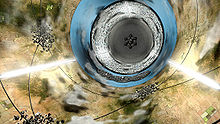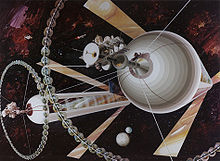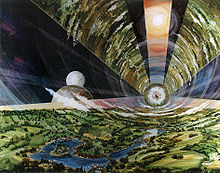- Island Three
-
The O'Neill cylinder (also called an Island Three habitat) is a space settlement design proposed by American physicist Gerard K. O'Neill in his 1976 book The High Frontier: Human Colonies in Space.[1] In the book, O'Neill proposed the colonization of space for the 21st century, using materials extracted from the Moon.
An O'Neill cylinder would consist of two counter-rotating cylinders, each 5 miles (8.0 km) in diameter and 20 miles (32 km) long, connected at each end by a rod via a bearing system. They would rotate so as to provide artificial gravity via centrifugal force on their inner surfaces.[1]
Contents
Background
While teaching undergraduate physics at Princeton University, O'Neill set his students the task of designing large structures in space, with the intent to show that living in space could be desirable. Several of the architectures were able to provide areas large enough to be suitable for human habitation. This cooperative result inspired the idea of the cylinder, and was first published by O'Neill in a September 1974 article of Physics Today.[2]
Islands One, Two and Three
O'Neill created three reference designs, nicknamed "islands":
Island One
Island One is a rotating sphere measuring one mile in circumference (1,681 feet or 512.27 meters in diameter), with people living on the equatorial region (see Bernal sphere). A later NASA/Ames study at Stanford University developed an alternate version of Island One: the Stanford torus, a toroidal shape 1,600 meters (just under a mile) in diameter.[3]
Island Two
Island Two is also spherical in design, and is also 1,600 meters in diameter.
Island Three
Island Three consists of two counter-rotating cylinders, each five miles (8 km) in diameter, and capable of scaling up to twenty miles (32 km) long.[4] Each cylinder has six equal-area stripes that run the length of the cylinder; three are transparent windows, three are habitable "land" surfaces. Furthermore, an outer agricultural ring, 10 miles (16 km) in radius, rotates at a different speed to support farming. The habitat's industrial manufacturing block is located in the middle, to allow for minimized gravity for some manufacturing processes.
To save the immense cost of rocketing the materials from Earth, these habitats would be built with materials launched into space from the Moon with a magnetic mass driver.[1]
Artificial gravity
The cylinders rotate to provide artificial gravity on their inner surface. Due to their very large radii, the habitats would have to rotate only about forty times an hour to simulate a standard Earth gravity. Research on human factors in rotating reference frames[5][6][7][8][9] indicate that almost no-one (at such low rotation speeds) would experience motion sickness due to coriolis forces acting on the inner ear. People would be able to detect spinward and antispinward directions by turning their heads, and any dropped items would appear to be deflected by a few centimetres.[10]
The central axis of the habitat would be a zero-gravity region, and it was envisaged that recreational facilities could be located there.
Atmosphere and radiation
The habitat was planned to have oxygen at partial pressures roughly similar to terrestrial air, 20% of the Earth's sea-level air pressure. Nitrogen would also be included to add a further 30% of the Earth's pressure. This half-pressure atmosphere would save gas and reduce the needed strength and thickness of the habitat walls.[1][11]
At this scale, the air within the cylinder and the shell of the cylinder provide adequate shielding against cosmic rays.[1]
Sunlight
Large mirrors are hinged at the back of each stripe of window. The unhinged edge of the windows points toward the Sun. The purpose of the mirrors is to reflect sunlight into the cylinders through the windows. Night is simulated by opening the mirrors, letting the window view empty space; this also permits heat to radiate to space. During the day, the reflected Sun appears to move as the mirrors move, creating a natural progression of Sun angles. Although not visible to the naked eye, the Sun's image might be observed to rotate due to the cylinder's rotation. The light reflected from the mirrors is polarized, which might confuse bees.[1]
To permit light to enter the habitat, large windows run the length of the cylinder.[1] These would not be single panes, but would be made up of many small sections, to prevent catastrophic damage, and so the aluminum or steel window frames can take most of the stresses of the air pressure of the habitat.[1]
Occasionally a meteorite might break one of these panes. This would cause some loss of the atmosphere, but calculations showed that this would not be an emergency, due to the very large volume of the habitat.[1]
Attitude control
 Interior illustration of the "Rama" mobile O'Neill cylinder, from Arthur C. Clarke's Rendezvous with Rama series.
Interior illustration of the "Rama" mobile O'Neill cylinder, from Arthur C. Clarke's Rendezvous with Rama series.
The habitat and its mirrors must be perpetually aimed at the sun to collect solar energy and light the habitat's interior. O'Neill and his students carefully worked out a method of continuously turning the colony 360 degrees per orbit without using rockets that would discard reaction mass.[1] First, the pair of habitats can be rolled by operating the cylinders as momentum wheels. If one habitat's rotation is slightly off, the two cylinders will rotate about each other. Once the plane formed by the two axes of rotation is perpendicular in the roll axis to the orbit, then the pair of cylinders can be yawed to aim at the sun by exerting a force between the two sunward bearings. Pushing the cylinders away from each other will cause both cylinders to gyroscopically precess, and the system will yaw in one direction, while pushing them towards each other will cause yaw in the other direction. The counter-rotating habitats have no net gyroscopic effect, and so this slight precession can continue for the habitat's orbit, keeping it aimed at the sun.
Criticism of the design
O'Neil's designs for the colonies are inefficient in their construction, in terms of materials used per square meter of living area. For example, to hold air at 40% of Earth's surface pressure with a standard 5-fold safety margin, the smallest design, the 1.5-km-diameter Island One, would require a steel shell with 2 metric tons of steel per square meter of shell. In contrast, a habitat made of linked 10-meter balls would requires only 24 kilograms of steel per square meter. The habitable area is distributed in different ways in such different designs, but the difference in costs remains huge.
See also
References
- ^ a b c d e f g h i j O'Neill, Gerard K. (1977). The High Frontier: Human Colonies in Space. New York: William Morrow & Company. ISBN 0-688-03133-1.
- ^ O'Neill, Gerard K. (September 1974). "The Colonization of Space" (PDF (subscriber only)). Physics Today 27 (9): 32–40. ISSN 0031-9228. http://ptonline.aip.org/getpdf/servlet/GetPDFServlet?filetype=pdf&id=PHTOAD000027000009000032000001&idtype=cvips. Retrieved 2009-04-19.
- ^ Space Settlements, A Design Study, 1977, NASA SP-413, accessed June 4, 2009
- ^ "O'Neill Cylinder". Orbital Space Settlements. National Space Society. http://www.nss.org/settlement/space/oneillcylinder.htm. Retrieved 2009-04-19.
- ^ Beauchamp, G.T.:Adverse Effects Due to Space Vehicle Rotation, Astronautical Sciences Review, vol. 3 no. 4 Oct-Dec. 1961, pp.9-11
- ^ Proceedings of the Symposium on the Role of the Vestibular Organs in Manned Spaceflight, NASA SP-77, 1965; Especially helpful: Thompson, Allen B.:Physiological Design Criteria for Artificial Gravity Environments in Manned Space Systems
- ^ Newsom, B.P.:Habitability Factors in a Rotating Space Station, Space Life Sciences, vol. 3, June 1972, pp192-197
- ^ Proceedings of the Fifth Symposium on the Role of Vestibular Organs in Space Exploration, Pensacola, Florida, August 19–21, 1970, NASA SP-314, 1973
- ^ Altman, F.:Some Aversive Effects of Centrifugally Generated Gravity, Aerospace Medicine, vol. 44, 1973, pp.418-421
- ^ Proceedings of the Fifth Symposium on the Role of Vestibular Organs in Space Exploration, Pensacola, Florida, August 19–21, 1970, NASA SP-314, 1973
- ^ Space Settlements, A Design Study, 1977, NASA SP-413, accessed June 4, 2009
Further reading
- T. A., Heppenheimer (2007) [1977]. Colonies in Space (online book ed.). National Space Society. ISBN 0811703975. http://www.nss.org/settlement/ColoniesInSpace/index.html. Retrieved 2009-04-19.
External links
Space stations and habitats Active Defunct Soviet Union
and RussiaUnited StatesCancelled ISS-incorporated Developmental ChinaSpace Complex Alpha · Space Complex BravoRussiaProposed Rotating wheel · Bernal sphere · O'Neill cylinder · Stanford torus · Wet workshop · Space habitat · Industrial Space Facility · Orbital Technologies Commercial Space Station1 Never inhabited 2 Failed launch 3 Part of the Almaz military program Categories:- Megastructures
- Space colonization
- Space stations
Wikimedia Foundation. 2010.



